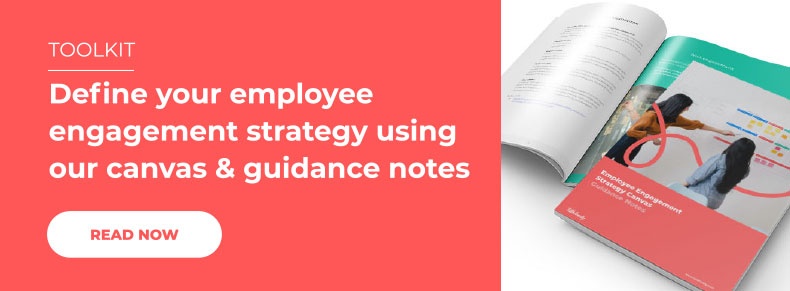We all talk about the business benefits of fully engaged employees. Employee engagement affects performance, productivity and profits. It impacts employee well-being, customer service, recruitment and retention. Quite simply, it’s central to business success. But, here’s the big question… How do you know if your employees are engaged in the first place? What does an engaged employee actually look like?
In this blog, we explore how the concept of ‘engagement’ manifests itself in the everyday thoughts and actions of your workforce. How do engaged employees really feel about their jobs? The following attitude statements reveal the mindset of a truly engaged employee.
These examples of employee engagement will help you to pinpoint the critical areas you need to address to boost your business performance.
Employee engagement example #1
“I feel well-informed. I know what’s going on in the company.”
Communication lies at the heart of all employee engagement strategies. It’s essential to ensure employees are kept fully informed about what the company is doing. And crucially, they also need to understand why the company is doing it in the first place. When you make sure employees feel connected to the bigger picture, they are much more motivated to work towards common goals. Well-informed employees have a greater sense of belonging, which leads to improved performance.
Without this element in place, employees may become disillusioned or distrustful of management. If employees don’t see the point of their roles and cannot see their importance to the company, you can guarantee that performance will suffer as a result.
Action point: Keep up a steady stream of internal communication, covering both internal and external updates. A company newsfeed is one of your most important employee engagement tools and will deliver instant benefits.
Employee engagement example #2
“My company has a good reputation. I’m proud to work here.”
A company that is highly respected in the industry and has a good public image will reap the rewards in more than one aspect. It will not only enjoy financial success in the marketplace, but it will also have highly engaged employees. The success of the company feeds directly into the employee’s self-esteem. Employees will take pride in their work and feel their role in supporting the company’s success has real value. Company pride is one of the key drivers of employee engagement.
Conversely, engagement levels fall dramatically when employees feel ashamed of their employer. While an engaged employee will be a positive advocate for their company, a disenchanted one could do real damage on social networks. Staff turnover is also likely to increase as employees seek positions with better-regarded businesses.
Action point: Corporate social responsibility is often seen as a box to tick, but it takes real action to make it work. Make sure you communicate all your environmental and social initiatives, both publicly and internally.
Employee engagement example #3
“I feel safe in my job. I’m confident in my long-term security.”
In the current economic climate, job security is even more important than ever. Following the last few years of upheaval, and the ongoing uncertainty regarding the cost of living, people need to know their jobs are safe. Employee engagement and retention depend on the surety of employment. When employees feel secure, they can relax and bring their best efforts to the role. In short, they need to know that their role will still be there tomorrow.
Without job security, you can be sure your employees will be looking for alternative options. This insecurity will also impact their job performance and work engagement. Employees who are uncertain about their long-term prospects will not be giving you their best work.
Action point: Leaders have a big role to play in communicating job security. From the CEO right through to direct management, there should be a strong emphasis on delivering information that reassures.
Employee engagement example #4
“I have a voice. My ideas and opinions are heard and valued.”
The importance of employee voice is an example of employee engagement that can’t be overstated. It’s now even more essential in the new hybrid working environment. Remote employees can quickly feel distanced from their office-based colleagues and manager. Actively encouraging feedback and ideas is essential. When employees trust management to be open to their ideas and suggestions, they feel part of the bigger picture.
Too often, internal communications are delivered as a one-way channel from the top down. If no feedback channel is implemented, employees will feel that their opinions are not valued. A two-way channel of communication is one of the key employee engagement best practices.
Action point: Look into ways of opening up your communication channels. An employee engagement app has ready-made feedback channels that allow your employees to speak out, offer ideas and provide essential feedback.
Employee engagement example #5
“My company recognises and rewards people who do a good job.”
Recognition is a powerful driver, especially when it’s made public. Openly thanking and rewarding employees for a job well done will have a huge impact on morale. And it won’t only affect the individual or teams involved. The positive influence will spread company-wide. Conversely, if your employees feel that hard work goes unrewarded, or there is favouritism in the ranks, this may create an unhealthy competitive workplace.
Of all the employee engagement action plan examples, recognition programmes are the most immediately impactful. Put simply, if you’re exploring how to increase employee engagement, recognition has to be on your hit list. It encourages employees to support each other, and makes them strive for personal recognition.
Action point: Consider implementing an employee recognition programme. An employee engagement platform will have the tools you need to create a positive culture of appreciation, encouraging peer-to-peer recognition as well as leadership rewards.
Employee engagement example #6
“I am part of a team. We all work together towards a common goal.”
Teams that work well together are profitable. Teams that are in conflict are not. When tensions rise between team members and management, productivity takes a backseat, to the cost of the business. Recent research reveals that workplace conflict costs UK employers £28.5 billion every year. That’s just over £1,000 on average for every employee. It’s one of those employee engagement statistics worth taking note of.
However, when teams are communicating effectively, people can concentrate on their work. By keeping communication flowing smoothly, you ensure any inter-office conflict is kept to a minimum and handled effectively when it does arise. In today’s hybrid workplace, the need to keep people talking, whether working from home or the office, is paramount.
Action point: Teams need to talk, so create a social space where they can do just that. An employee engagement app offers conversation modules, allowing employees to meet, chat and share online. It’s a great way to bridge the gap for remote workers.
Employee engagement example #7
“I feel empowered. I’m trusted to make my own decisions.”
Giving your employees more decision-making power invigorates both them and the company. Why? Because when we choose for ourselves, we are far more committed to the outcome. The ideal form of leadership is not telling people what to do. Instead, you should empower your team to make their own strategic choices aligned with the company goals.,
Employee engagement theory talks a lot about visible empowering leadership. Allowing your employees to make the right choices gains far more commitment than telling them what to do. If your employees feel their hands are tied, productivity will suffer because they will be waiting for someone else to make decisions first.
Action point: The key to empowerment lies in a strong company culture. Your company's values must be reflected in day-to-day behaviours, from top to bottom. Leaders should offer a solid narrative about the organisation, providing a template for employees to follow.
These examples of employee engagement show us what a truly engaged employee is really thinking. Now that we know the mindset of an engaged employee, we can implement strategies to replicate that winning attitude across the company.









.jpg)
.jpg)